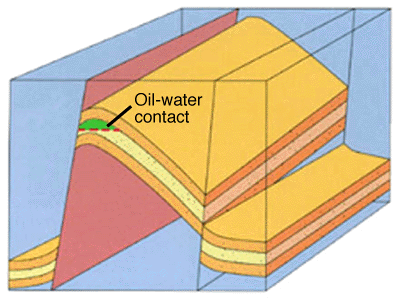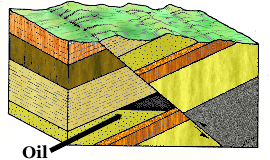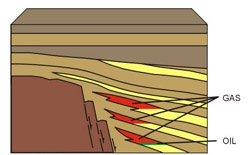Types of Petroleum Traps
Petroleum traps have been classified by Geologists into 2 varieties, structural traps and stratigraphic traps. Deformation in the rock layer that contains the hydrocarbons form structural traps. Fault traps and anticlines are two common examples of structural traps.
An anticline is an upward fold in the layers of rock resembling an arch in a building. In this type of trap petroleum migrates into the highest part of the fold. It’s escape is prevented by impermeable rock overlaying the trap.
A fault trap occurs when the formations on either side of the fault have been moved into a position that prevents further migration of petroleum. The petroleum can become trapped by an impermeable formation on one side of the fault that has moved opposite the petroleum-bearing formation on the other side of the fault. The impermeable layer prevents further migration of the petroleum.
When a reservoir bed is sealed by other beds or by a change in porosity or permeability of the bed itself a stratigraphic traps is formed. Stratigraphic traps come in many varieties. In one variety, a tilted or inclined layer of petroleum-bearing rock is truncated by an essentially horizontal, impermeable rock layer.
Sometimes a petroleum-bearing formation pinches out or rather, the formation is gradually cut off by an overlying layer. Sometimes a stratigraphic trap occurs when a porous and permeable reservoir bed is surrounded by impermeable rock. Another possibility is that there is a change in porosity and permeability in the reservoir bed itself. Sometimes the upper reaches of the reservoir may be impermeable and nonporous, while the lower part is permeable and porous and contains hydrocarbons.

Anticlinal Petroleum Trap

Fault Petroleum Trap

Stratigraphic Traps


